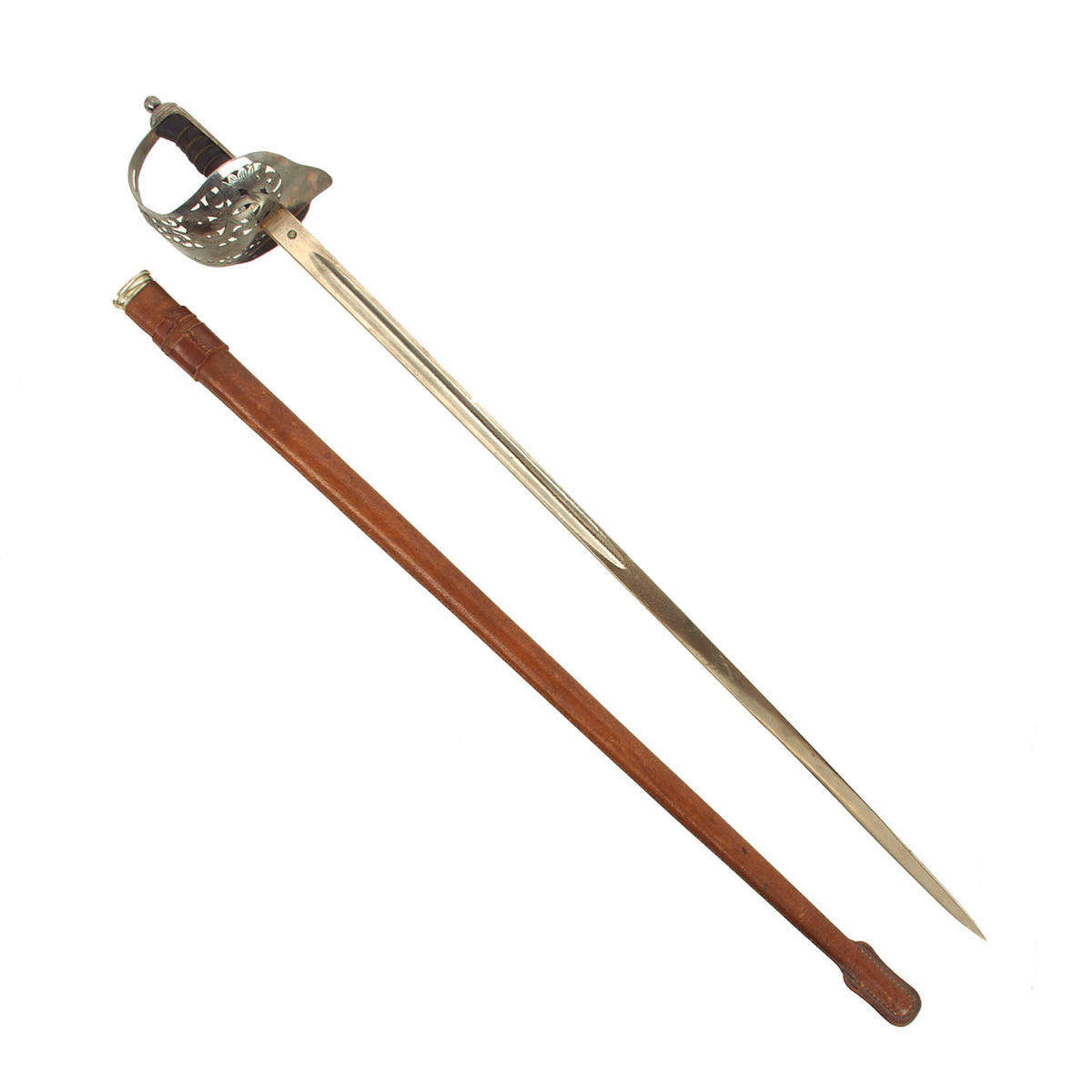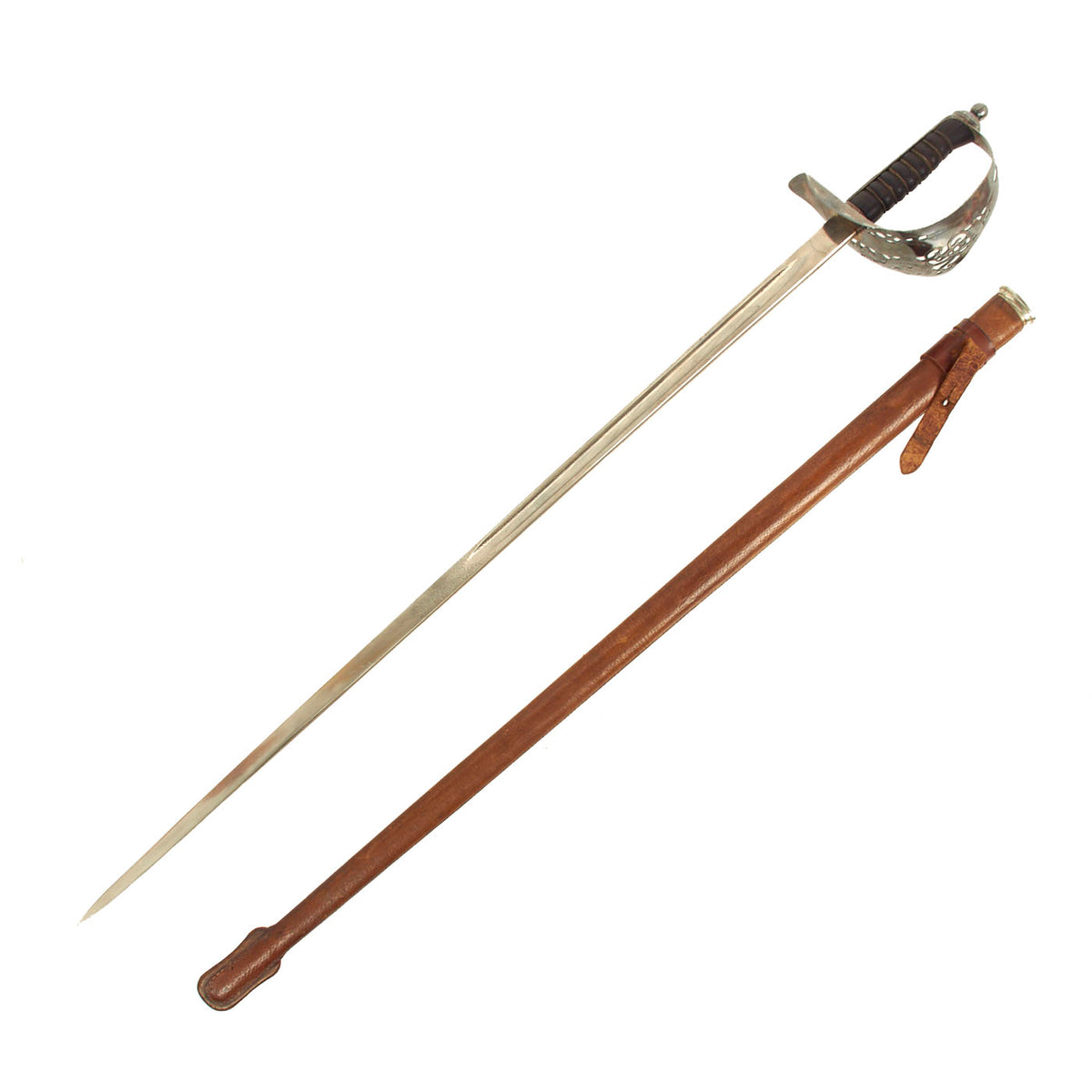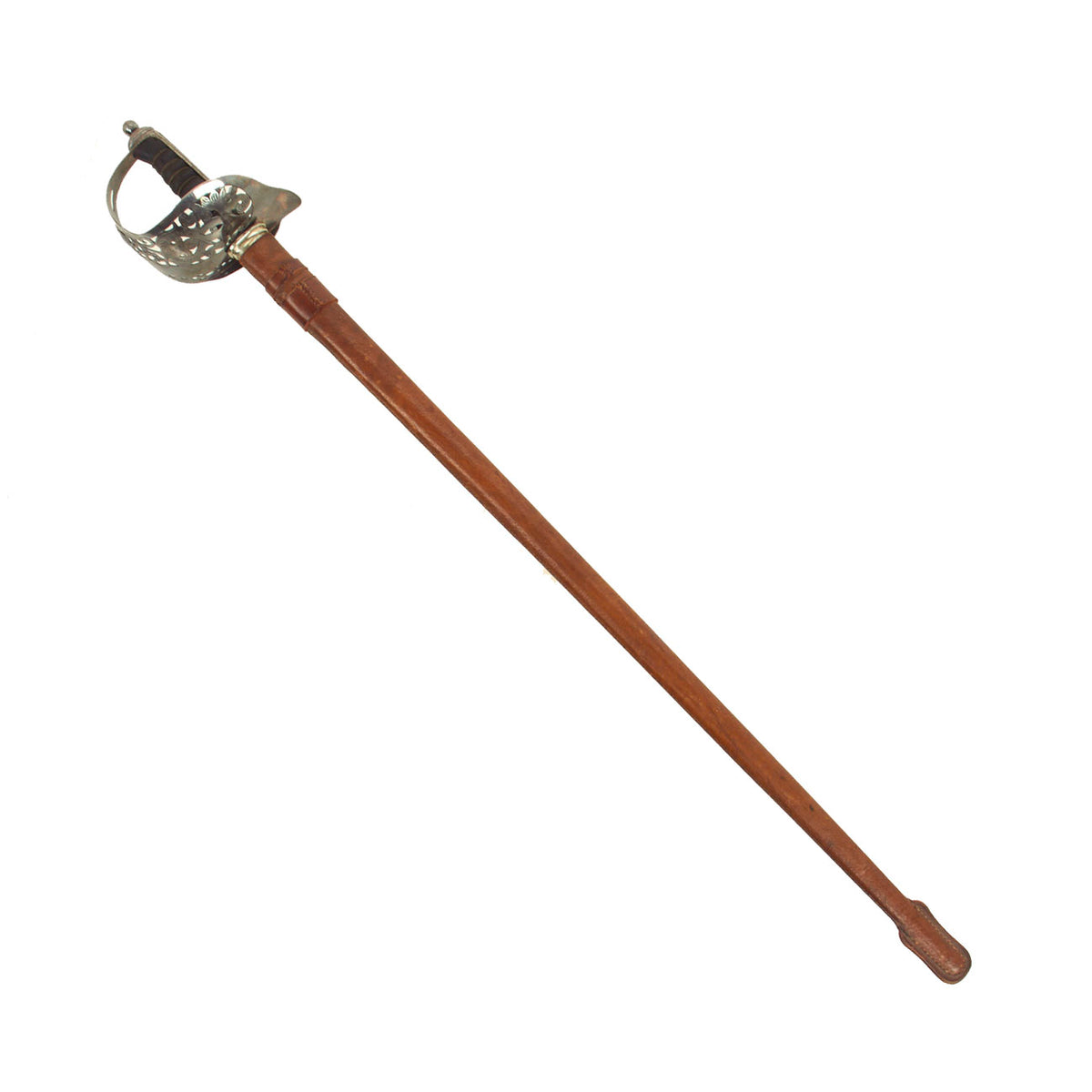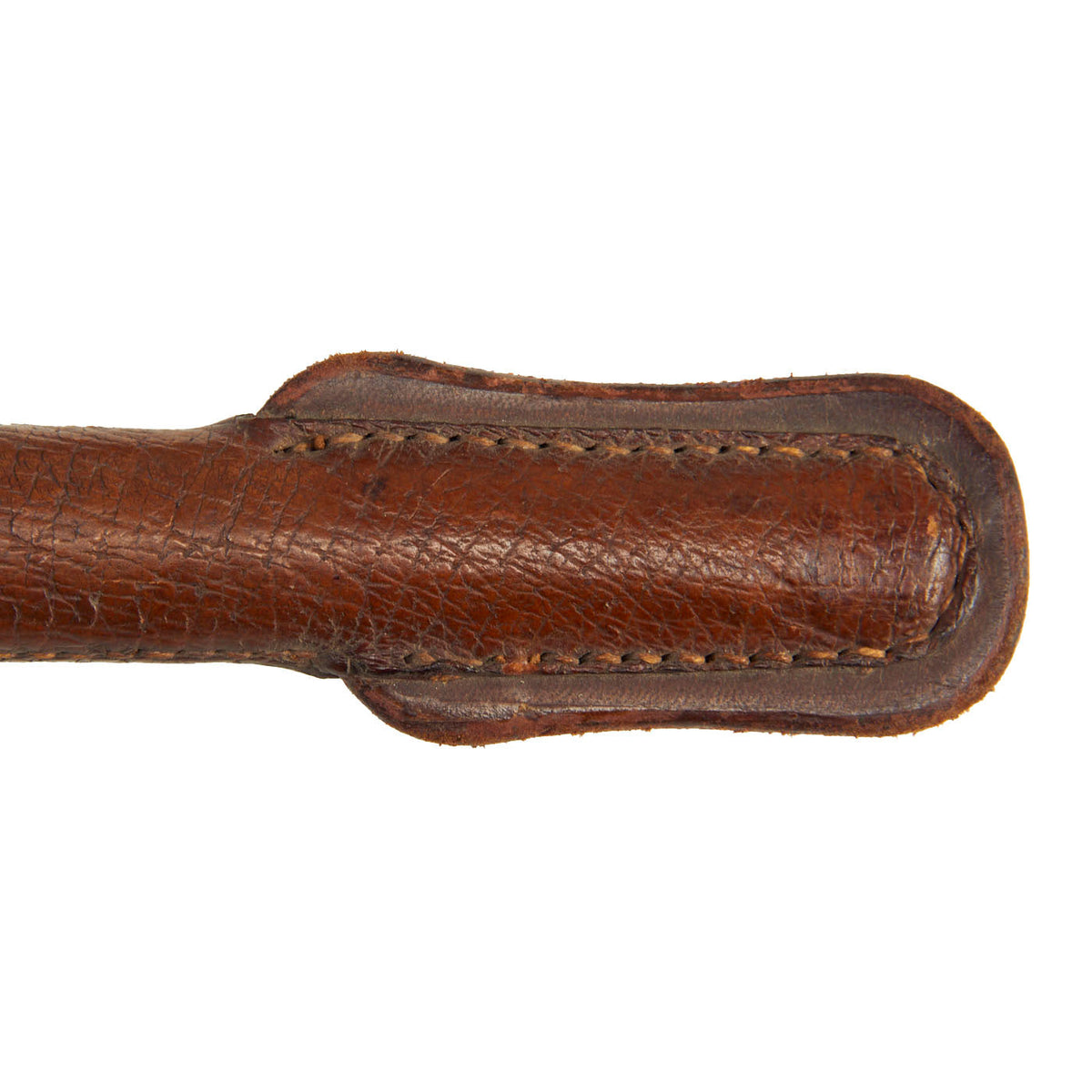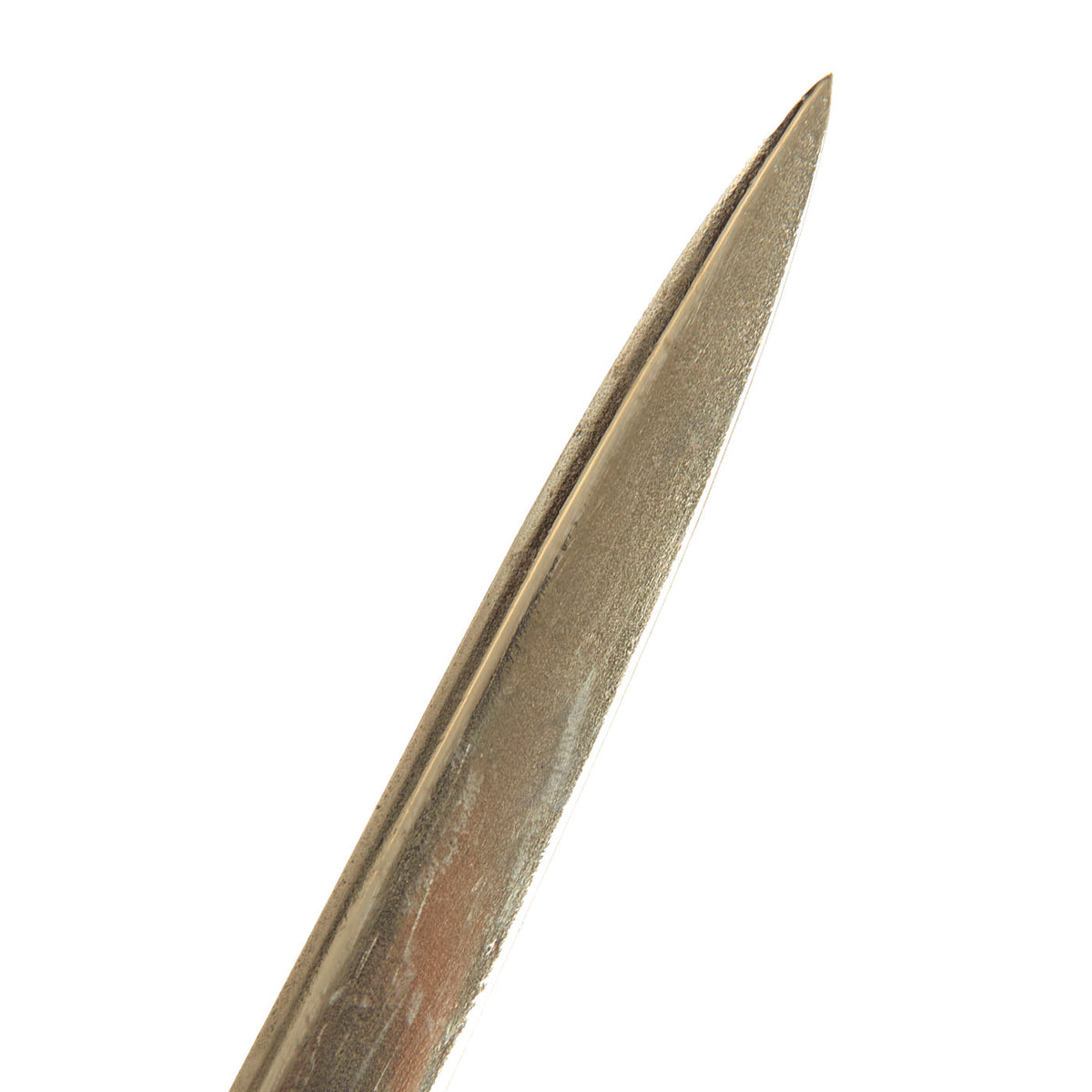Original British WWI Pattern 1897 Officer’s Sword and Scabbard Presented to Captain W.T. Fisher, 1st Battalion Essex Volunteer Regiment Original Items
$ 895,00 $ 223,75
Original Item: Only One Available. This is a great example of a British Pattern 1897 Infantry Officer’s sword that was presented to a captain during World War I. The presentation is located underneath the guard and reads “Presented to / Captain W.T. FISHER / by the N.C.Os & MEN of / B. COMPANY / 1st BATTALION ESSEX / VOL. REGT. / April 5th, 1917“.
The 1st Battalion Essex Regiment accumulated an impressive combat record during the war, starting in Mauritius when the war began, traveled back to England in 1914, trained for France, but departed for Gallipoli, landing at Cape Heles on April 25, 1915. After heavy fighting they sailed to Egypt, eventually ending up in France where the regiment experienced more hard fighting in battles such as the Somme, the Battle of Langemarck, Broodseinde, and Poelcapelle.
The sword is in standard Pattern 1897 configuration with a thrusting blade that lacks sharp edges. The blade is decorated with scrollwork and English motifs. Large guard with open scrollwork and knuckle bow slotted to accommodate a sword knot. Checkered backstrap with large ball finial. Complete with steel scabbard with leather wrap.
Blade exhibits a bright finish with scattered blemishes. Guard exhibits areas of pitting, especially at the quilon area and underside. Grip exhibits wear with several small cracks and slightly loose wire Scabbard remains sturdy with nice leather wrap that exhibits a few scattered blemishes.
A lovely sword ready for further research and display!
Specifications:
Blade Length: 32 3/4″
Overall length: 39“
Basket dimensions: 5 1/2″ width x 5 1/2” length
Scabbard Length: 34″
Pattern 1897 Infantry Officer’s Sword
The curved, Gothic-hilted 1822 and 1845 pattern infantry swords, although elegant, had been criticized by some as fighting swords. In common with British cavalry swords of the era, they were cut-and-thrust swords.
In 1892, a new, straight, blade was introduced, mated to the existing Gothic hilt. Presaging the introduction of the 1908 pattern cavalry sword, the curved blade was abandoned in favor of a straight, stiff blade optimized for the thrust. Credit for the design has been given to Colonel G. M. Fox, Inspector of Gymnasia at Aldershot, who was also influential in the design of the pattern 1908 cavalry sword.
In 1895, a new pierced steel hilt pattern was introduced, replacing the earlier Gothic hilt with a three-quarter basket hilt. The new pattern was short-lived due to the edge of the guard fraying uniforms, and in 1897 the final pattern was settled on, being simply the 1895 pattern with the inner edge of the guard turned down, and the piercings becoming smaller.
By the time of its introduction, the sword was of limited use on the battlefield against rapid-firing rifles, machine guns and long-range artillery. However, the new sword was regarded, when needed, as a very effective fighting weapon. Reports from the Sudan, where it was used in close-quarters fighting during the reconquest of the Sudan (1896-’99) were positive. Officers carried swords into battle in 1914 at the start of the First World War, and some were still being used in action at the Battle of Neuve Chapelle in March 1915. That June, Army Order 68 prohibited the carrying of swords by infantry on the battlefields of the European theater of the war, in an effort to prevent officers making themselves conspicuous to the enemy; however, at least one sword was carried in the assault on the first day of the Battle of the Somme in June 1916. Bernard Montgomery advanced with his 1897 pattern sword drawn during a counteroffensive in October 1914; having never received any training on how to use it. The actual sword he carried is exhibited in the Imperial War Museum, London.
The design of the 1897 pattern has remained unchanged to the present day, and is now manufactured by various companies, including Weyersberg, Kirschbaum & Cie of Germany and Pooley Sword of the UK. Until 2004, swords of this pattern would be used in courts-martial by escorts of the accused and if the accused was an officer, he would lay his sword on the table for judgment.
Design
The blade is described in the pattern as being 32+1⁄2 inches (830 mm) long and 1 inch (25 mm) wide at the shoulder, with the complete sword weighing between 1 pound 12 ounces (0.79 kg) and 1 pound 13 ounces (0.82 kg).
The blade is straight and appears symmetrical in shape (though in cross-section is a wedge, with the edge towards the front). The thick blade has a deep central fuller on each side and is rounded on both its edge and back towards the hilt, giving a “dumbbell” or “girder” cross section. Through a gradual transition, the blade becomes a wedge-section with the main cutting edge towards the front. The last 17 inches (430 mm) of the front edge was sharpened when on active service (and a few inches of the false edge, at the back near the tip, to aid penetration). The blade ends in a sharp stiff spear point.
The blade is usually decoratively etched on both sides.
The guard is a three-quarter basket of sheet steel. It is decorated with a pierced scroll-work pattern and has the royal cypher of the reigning monarch set over the lower knuckle bow.
The grip, between 5 and 5+3⁄4 inches (130 and 150 mm) long to suit the hand of the owner, is generally covered in ray or sharkskin and wrapped with German-silver wire. The grip is straight, with no offset to the blade.
The sword shows a number of features that indicate its intent as a thrusting weapon. The stiff tapering narrow point aids penetration. The blade, whilst quite narrow, is thick and its dumbbell section gives it good weak-axis buckling strength whilst maintaining robustness in bending for the parry. The blade tapers in both width and thickness and, with the substantial guard, has a hilt-biased balance, aiding agility at the expense of concussive force in a cut. The guard gives comprehensive protection to the hand, but does not restrict wrist movement. The length of the front edge, at 17 inches (430 mm), is quite significant, suggesting that some cutting capability was maintained, even if the blade design is clearly intended as a thruster.
Fast Shipping with Professional Packaging
Thanks to our longstanding association with UPS FedEx DHL, and other major international carriers, we are able to provide a range of shipping options. Our warehouse staff is expertly trained and will wrap your products according to our exact and precise specifications. Prior to shipping, your goods will be thoroughly examined and securely secured. We ship to thousands clients each day across multiple countries. This shows how we're dedicated to be the largest retailer on the internet. Warehouses and distribution centres can be located throughout Europe as well as the USA.
Note: Orders with more than one item will be assigned a processing date depending on the item.
Before shipping before shipping, we'll conduct a thorough inspection of the items you have ordered. Today, the majority of orders will be delivered within 48 hours. The delivery time will be between 3-7 days.
Returns
The stock is dynamic and we cannot completely manage it because multiple stakeholders are involved, including our factory and warehouse. So the actual stock may alter at any time. It's possible that you may not receive your order once the order has been made.
Our policy is valid for a period of 30 days. If you don't receive the product within 30 days, we are not able to issue a refund or an exchange.
You can only return an item if it is unused and in the same state as the day you received it. You must have the item in its original packaging.
Related products
Uncategorized
Uncategorized
Uncategorized
Band of Brothers ORIGINAL GERMAN WWII Le. F.H. 18 10.5cm ARTILLERY PIECE Original Items
Uncategorized
Uncategorized
Uncategorized
Uncategorized
Armored Burgonet Helmet & Polearm from Scottish Castle Leith Hall Circa 1700 Original Items
Uncategorized
Angolan Rebel 1970s era 60mm Inert Display Mortar from Angolan Civil War Original Items
Uncategorized
Uncategorized
Uncategorized
Australian WWII Owen MK1 Machine Carbine SMG Custom Fabricated Replica with Sling Original Items
Uncategorized
Uncategorized
Uncategorized
Uncategorized
Uncategorized
Uncategorized
